This Post May Contain Affiliate Links
In compliance with the FTC guidelines, please assume that some of the links on these posts and sites are affiliate links (Amazon or others) from which I may earn a small compensation/commission from sales of certain items at no extra cost to you from qualifying purchases.
Anytime you see a link that looks like “astore.com, paid link, #ad, #CommissionsEarned or Amazon/Amazon.com/ca,”… it can be assumed that it is an affiliate link.
To learn more, follow the link below.
A Look At The Multi Scale Guitar
What Is The Scale Length Of A Guitar?
Also referred to as “string length,” scale is commonly measured in inches and identified as the distance between the Bridge and the nut or the maximum length of an opened string that vibrates freely producing sound. (See Image)

The standard scale lengths used by the leading brands are generally identified by one measurement.
(i.e. The Gibson Les Paul Scale length is 24.74″ or the Fender Stratocaster is 25.5″)
Design Concepts Rethought
With new electric Extended-range guitars sporting more than the traditional 6 strings, scale lengths must be rethought and new designs applied for improved playability.
The problem with having the same scale for each string on Extended-range models is that the lower strings may not have the appropriate scale lengths to get proper pitch.
Even on a 6-string with drop-tunings, strings can become quite loose and create challenges.
Because string tension is traditionally dictated by using appropriate guages for your scale, players typically increase string gauge thickness or purchase hybrid string sets to overcome this problem.
But it only works up to a point. (i.e. you may need to modify some of your hardware to accommodate the heavier gauges.)
Extended range is a term used for electric guitars with extra strings, usually on the lower registry for added sonic tones and can range from 7-9 string options.
Challenging Play
As you tighten the lower strings with heavier guages on standard scales, you simultaneously make the high strings more challenging to play; conversely, if you loosen up the higher guages, the lower strings become more flimsy.
What happens when you need more tension on lower-tuned strings but less on the higher strings to adjust for bending and vibrato, even on a light gauge?
As you add more strings to an instrument and have the lower or custom tunings, it is more challenging to get the guitar to pitch on a standard shorter scale length (even with Hybrid strings), for heavier gauge strings vibrate better on longer scale lengths.
This is the concept behind Bass & some Extended-range guitars, where the strings need enough length to sustain low vibrations.
(i.e. 7-string electric guitars usually have scale lengths of 25.5″ to 26.5″ and 8-string electric guitars normally vary between 27″ and 29.4″.)
Enter The Multiscale
Also called the Fanned Fretted or Multiple-scale Length Fretboard Guitar.
The design incorporates multiple scale lengths, allowing each string to have a different scale & tension.
Each string has optimum length for pitch and playability across the whole fingerboard, resulting in improved bass string response without compromising the quality of the shorter scale high treble strings.
(See Image)
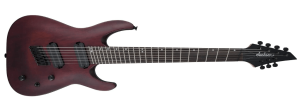
A Jackson X Series Dinky Arch Top DKAF 7-string Multiscale w/Laurel Fingerboard, & Stained Mahogany Electric Guitar-Image courtesy of Amazon – Tap Image to see more.
How It Works
The design incorporates…
- A longer or elongated scale length for the low strings (e.g. 28″)
- A shorter scale for the highest string (e.g. 25.5″) with the Strings between also having their unique lengths.
So rather than a single measurement, such as 25.5″, you get a scale range or ” Spread.” (More on this later)
Balance Tension & Tones
Higher tension on the low strings and lower tension on the higher strings produce a balanced range of tonal characteristics and playability.
Due to the rise in popularity, this design is making its mark with the more prominent guitar brands, creating production models of multiscale instruments.
Why Call It A Fanned Fret?
First credited by Luthier Ralph Novak (Novax Guitars), a blues guitarist looking for more flexibility on the higher register but wanted nice clean crisp, low-end, unavailable in the guitar designs and strings of the day.
Innovation From Necessity
Novak patented the concept (1988-2009) and trademarked the term “Fanned Fret.”
His designs angled the frets on the fretboard like a fan instead of the standard perpendicular models, claiming the new concept would improve…
- Comfort
- Ergonomics &
- Improved tension across the fretboard
Fanned frets work by giving each string the optimal length to suit the pitch of the string, and as scale length increases, the angle of the ‘Fan’ tends to become more extreme.
Along with the Fanned frets, Multiscale guitar designs also place the Bridge, pickups & nut on a calculated angle. (Designs may vary per make & model.)
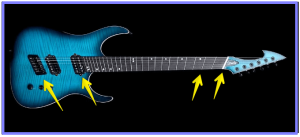
The Ormsby Hype GTR 6 Multiscale in Beto Blue- w/Angled Bridge, pickups, frets & nut-Image courtesy of reverb.com
Not A New Concept
With the piano being around since the early 1700s, this concept is not new.
If you were to open up a piano, you would see that every string has its own scale length tuned to proper pitch and tension.
The lower strings are thicker & longer for more precise tones than the thinner high counterparts.
(See Image)

The internal parts of a Grand Piano showing the arrangement of string lengths to accommodate for proper pitch & tensions-Image courtesy of yamaha.com
The same principle applies to Multiscale guitars.
Utilizing a guitar fingerboard identical to a piano creates the same effect and fixes the challenges of having extra strings.
History Of Multiscale Instruments
Along with the piano, the history of Multiscale instruments stretches back hundreds of years, with the Harp having existed since (est) 2500 BC and Fanned frets being used on stringed instruments as early as Renaissance times.
Acoustic instruments like the Bandora and Orpharion, invented by John Rose in the 16th Century, were known to sport fanned fret and angled bridge designs. (See Image)

Picture of an Orpharion by John Rose used in the frontispiece for William Barley’s Book of Tablature 1596-Author Australopithecus2-Image courtesy of Wikipedia and is licensed under the Creative Commons Attribution-Share Alike 4.0 International.
The “Spread”
Is a term used to describe the different measurements (given for the scale lengths) on a Multiscale, again commonly in inches.
The instrument is measured using two values…
- The Highest /Shortest &
- The Lowest/Longest
In the Image below, the high string has a slightly shorter scale length of 25.5″, whereas the lowest string has a longer scale length of 26.7.″
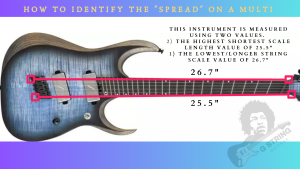
So, this guitar’s Multiscale length value is written as 25.5 “/26.7”, with the other strings falling between these two measurements. (Note some manufacturers reverse this process.)
The Neutral Point
When laying out the Fan of the frets, there is a Neutral point somewhere on the scale.
This is where the fret is “straight” or perpendicular to the strings, like a regular guitar.
The neutral point on a standard guitar is the 12th fret. But with fanned fretted models, the neutral fret is generally somewhere between the 7th -9th positions and as high as the 12th fret.
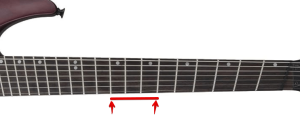
A Jackson X Series Dinky Arch Top DKAF7 Multiscale w/Neutral point between 7-9 frets-Image courtesy of Amazon -Tap Image to see more.
Variations To The Concept
Some Fanned fret guitars place the neutral point at the nut and Fan out only on one side instead of both, with all the frets angled in the same direction.
In this design version, the Fret angle gradually becomes more extreme as you move up the fingerboard. (See Image)
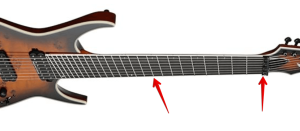
A Dean Exile Select 8 Multiscale Kahler Electric Guitar w/Neutral Point at the Nut position -Image courtesy of zzsounds.com – Tap Image to see more.
Why Is This Important?
The location on the fingerboard of the neutral point and overall feel depend on the fan design and play a part in how the guitar mimics the ergonomic motion that the arm makes when moving up and down the neck.
Benefits Of The Neutral Point
The neutral point and fanned frets will also dictate the Angle of the Bridge, which naturally impacts the guitar’s play and tension in the lower strings, allowing for a comfortable picking hand positioning and making techniques like Palm muting a breeze. (More on this later)
Who Is A Mult Scale Guitar For?
The answer is anyone!
But depending on your playing preference, it can affect your decision.
Multiscale 6-string Models

The Kaizen Apollo 6 String Multiscale Electric Guitar-Image courtesy of long-mcquade.com
The benefits of fanned frets on 6-string guitars in standard tuning are minor and not as apparent as on an extended-range guitar.
The tension across the strings on a standard guitar is pretty even, but this design can make sense for increased Tone, Tuning stability, Ergonomics or Drop Tunings.
Multiscale 7-string Guitar
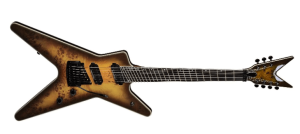
The Dean ML 7 String Select Multiscale Kahler Guitar, Ebony, Satin Natural Black Burst-Image courtesy of Amazon -Tap Image to see more.
Most 7-string guitars use a more extended scale (25.5″ and up) and can create high tension on the treble strings without proper gauges.
Most 7-string brands have this worked out with standard scale lengths, but this fanned fret concept can improve playability.
Multiscale 8-string Guitar
On an 8 or 9-string guitar, Fanned Frets are a must.
A Multiscale would significantly improve the Tone and Playability of the guitar.
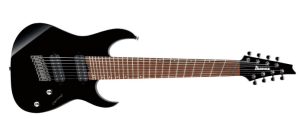
An Ibanez RG Multiscale 8-String Electric Guitar in Black- Image courtesy of Amazon. Tap Image to see more.
Rule Of Thumb
The more you move away from standard tuning or 6 and 7-string guitars, the more fanned frets are necessary.
Benefits Of The Multiscale/Fanned Fret Guitars
More Precise Tone Of Low-Frequency Notes
Because of the increased tension and extra string length across the thicker strings/with lower tunings, the pitch, frequency & string vibration give off a better resonance and Tone than a heavier string on a regular setup with drop-tuning that cannot vibrate as long.
Full Tone Of Higher-Pitched Notes
Where longer low-pitch strings need the extra scale to get optimum resonance, conversely, higher register tones resonate better on a shorter scale, resulting in rich and full tones of thinner, higher-tuned strings.
String Tension & Playability
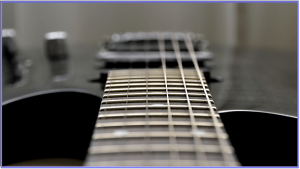
Because you get proper String Tension on all strings, playability on Multiscale extended-range guitars is comfortable, providing proper string tension in the lower strings without increasing or affecting the higher strings’ playability and allowing for effortless bending and vibrato anywhere on the fretboard, but especially on the higher registers.
Tuning Stability
With even string tension across the board, you’ll get better tuning stability, especially in Extended-range or drop-tuned models.
Low Tunings
As explained earlier, lower-pitched notes work best with long string lengths. This is why 8 & 9-string guitars often come with fanned frets as standard.
But if you tune down on a 6-string guitar (i.e. Drop-C), you will find that fanned frets make a big difference in playability; for a 6-string guitar with a standard scale would require heavy gauge strings to compensate for the lower pitches, while a fanned fret guitar would let you use lighter strings while keeping the string tension even across all 6 strings.
Also, it is good to note that a multiscale guitar doesn’t necessarily fix all the string problems; you might still need to get Hybrid string sets specially designed for Low tunings.
Playability & Ergonomics
With the location of the Neutral Point discussed earlier, as an added benefit, the angle of the frets makes for a much more ergonomic and comfortable positioning of the picking and fretting hand.
Instead of bending your wrist to align your fingers around traditional frets, fanned frets are ergonomically positioned around your fingers at an optimal angle, allowing for improved wrist comfort and playability.
Do Multiscale Guitars Improve Intonation?
What Is Intonation On A Guitar?
The term refers to how “in-tune” each fret position is across the string.
If your Intonation is off, your open string will sound fine, but when you fret a note, it will be out.
Because the guitar is generally flawed, it is notoriously difficult, perhaps even impossible, to have it perfect across the entire fretboard, with numerous fret positions being ever so slightly sharp or flat. It just can’t be helped.
Do Fanned Frets Offer Better Intonation?
Science tells us that the longer the guitar’s scale length, the better “in tune” it tends to be. This means a guitar with a 27″ scale length will have slightly better Intonation than a guitar with a 25.″
So, with this logic, technically fanned fret guitars with longer scale lengths on the lower strings should improve.
But only on a minor level and only on the lower strings, for the higher strings will have the same tuning issues as a regular guitar with the same scale length.
If you are looking for as close to perfect Intonation as possible, look to True Temperament Frets; this design aims to fix intonation problems found on standard model guitars.
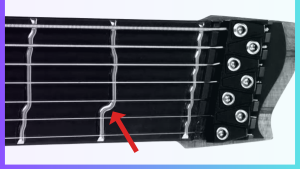
A Strandberg Boden+ NX 7 Electric Guitar w/True Temperament Fret design-Image courtesy of sweetwater.com
Created by Anders Thidell, True Temperament is a Fretting system designed to achieve accurate and precise Intonation on the guitar and promoted by many top guitar virtuosos like Steve Vai.
FAQ
Best Of Both Worlds
This design allows play like a regular guitar, even on Extended models, along with using drop tunings without heavy strings becoming too loose and causing fret buzz.
As you can see by merely looking at a multiscale guitar, the logical thinking behind it is to offer the player the best of both worlds.
Video
Final Thoughts
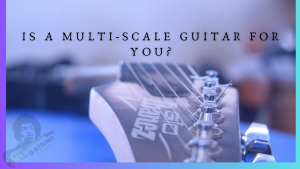
First off, I think the idea makes sense. Having a multiscale to improve Tension, Pitch, Playability, and overall Tonal quality is quite appealing, even on a 6-string.
Guitarists always look to improve the status quo in alternate tuning, technique, equipment, hardware, etc.
Do Multiscale Guitars Out-function Traditional Models?
We know they do not outsell their parallel fret competition for the costs and time it takes to build, along with the hardware and options available.
But a well-designed multiscale guitar offers you advantages that a standard model will not.
Should You Add This To Your Collection?
Every guitarist is different, so if you’re considering a multiscale guitar, try it out to see if it feels right.
It would be best if you found a guitar with the correct scale length and neutral point to suit your preferences.
In the future, I will enjoy not just toying with one at the local music shop but will purchase one for a stage instrument.
Did You Like This Article?
Check out the Brian HEAD Welch Signature 7 String Guitar.
Also…
Please leave your comments in the section below, and if you have a favourite player or guitar you would like me to review, leave a note below.
Stay the course, keep playing, and see you in a few weeks.
Feature guitar in the Blog Banner and the description of the Spread image is an RGD Iron Label Multi Scale Electric Guitar – Cerulean Blue Burst Flat-Image courtesy of long-mcquade.com
The first Image of the guitar for an explanation of scale length is courtesy of Clker-Free-Vector-Images from Pixabay.
Image of black electric with sting courtesy of PIRO from Pixabay
Final image courtesy of Harshit Kumar from Pixabay

Starting A Journey At 7 Years Of Age, The Love For The Guitar Only Became Stronger Going Into My Teens. This Leading To An Exciting Time Of Teaching, Performing, And Recording. Join Me Now As We Can Bring The Love Of This Instrument To Other Musicians Globally.

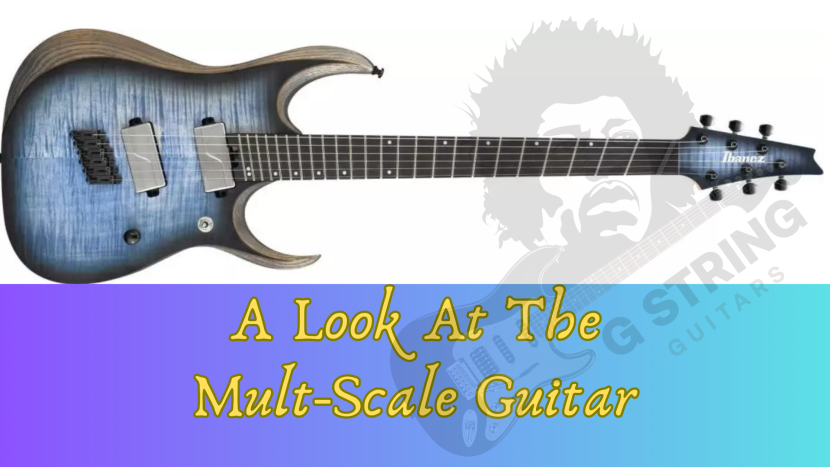

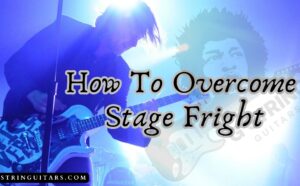

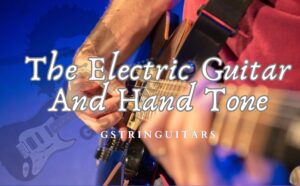
Thank you for providing such a comprehensive overview of the multi-scale guitar and its significance in the world of guitar design. Your explanation of scale length and how it impacts the distance between the bridge and nut, as well as the tension and pitch of strings, is highly informative.
It’s intriguing to learn how the introduction of extended-range guitars with more strings has led to a need for rethinking scale lengths and designs. The challenges of achieving proper tension and pitch on both low and high strings in drop-tunings make the multi-scale approach a necessity for achieving optimal playability and tonal characteristics.
The concept of the multi-scale guitar, also known as the Fanned Fretted guitar, seems like a revolutionary solution to the challenges posed by extended-range instruments. The idea of incorporating different scale lengths for each string to balance tension and tones across the fingerboard is ingenious. I’m particularly interested in how this design allows for improved bass string response without compromising the quality of the higher treble strings.
You mentioned the benefits of the neutral point, which affects the guitar’s play and tension in lower strings. Could you provide more insight into how the neutral point is determined and how it contributes to the overall ergonomic experience of playing a multi-scale guitar?
Thank you for sharing this in-depth analysis of the multi-scale guitar design, and I’m excited to learn more about this fascinating innovation.
Lou
Hello Lou
Nice to meet you, and thank you for visiting our site and leaving your feedback.
To further answer your questions on the neutral point, it is determined based on the manufacturer’s specs of the instrument’s overall design, scale, etc., where they decide the neutral point would best work.
From an ergonomic perspective, the fret angle allows for less wrist adjustment to achieve the desired notes or chords across the fretboard, and this will change based on whether the frets fan out in one direction or if they go out in two directions (Either side of the neutral point)
We will start to add more specialty guitars onto the site that add this design to their models, for i think it is a terrific addition to the perfection of the instrument.
In the meantime, do not hesitate to read more of our posts, like on the ESP LTD SH-7 Brian HEAD Welch Signature Guitar, for this model review inspired us to go down into new additional topics.
Also, feel free to leave your thoughts on some of our other posts that you might find interesting.
Dino@GSG
I’m quite fascinated by the concept of multiscale guitars, especially as someone relatively new to playing the guitar. I understand that the multiscale design can improve things like tension, playability, and tonal quality. However, I’m curious about the potential downsides.
The article mentions that there may be some cons to multiscale guitars. Could you elaborate on these drawbacks? And are there any specific scenarios or styles of playing where multiscale guitars might not be the best choice?
Hello Skamalka
Thank you for coming by and leaving your comments and thoughts.
To answer your questions about this design, the “Downside” is that it’s just not as mainstream in terms of hardware or power station replacement (not as many options to choose from,) along with adjusting picking hand for specific techniques like the palm mute.
Also as mentioned, if you are a 6 or 7 string player, Multiscale is more of a personal preference; this design is intended for 8-9-string extended guitars.
For instance, the 7 String ESP LTD SH-7 Brian HEAD Welch Signature Guitar is not multi but works well with the 25.5″ standard scale length.
But it is a great concept and I liked the feeling of the multiscale setup and how it felt both for the picking and the fretting hand.
About guitar styles, the multi will work with any genre you are currently playing a 6 or 7 string instrument for.
I will pick one up as one of my main stage instruments shortly.
Please do not hesitate to read more and leave your thoughts in the future.
Regards from dino@gstring